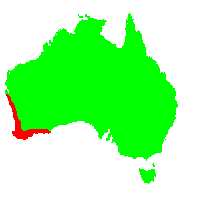General Description:
Thomasia is a genus of about 32 species, all occurring in Western Australia with one (Thomasia petalocalyx) also extending to South Australia and Victoria. Thomasias are generally small to medium shrubs in which the calyx of the flower is more prominent than the petals. The genus is closely related to Guichenotia, Lasiopetalum and Lysiosepalum.
Thomasia grandiflora is a small shrub which may reach about 1 metre high by a similar width. Leaves are dark green with recurved margins and may vary from heart-shaped (the typical form) to narrowly elliptical (var. angustissima) and 15 – 25 mm long. The bright pink to purple flowers occur in late winter and spring and are very conspicuous. They are about 20 mm in diameter with a “papery”, crinkled appearance. The flowers are followed by capsules containing black seeds which are shed from the plant when ripe.
Large flowered thomasia is popular in cultivation although it is best suited to areas with a dry summer climate. It can be difficult to maintain for long periods in districts with a humid summer. It requires well drained soils and will grow in full sun or partial shade. This species has been successfully cultivated at Santa Cruz Arboretum in California, USA.
Propagation can be carried out from seed but germination can be unreliable. Cuttings of firm, current season’s growth usually strike reliably.

Thomasia grandiflora
Photo: Murray Fagg – Australian National Botanic Gardens
 Australian Native Plants Society (Australia)
Australian Native Plants Society (Australia)













